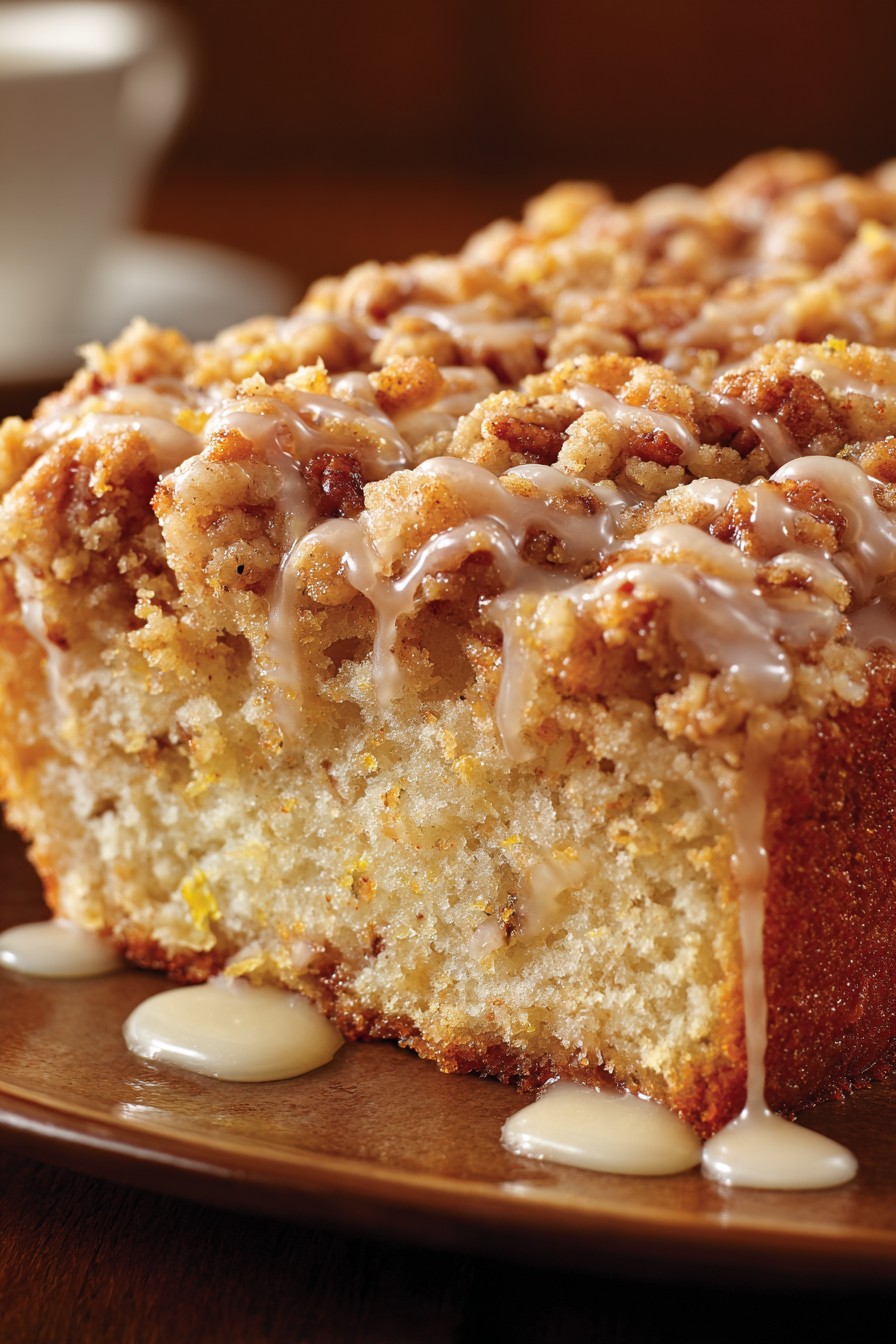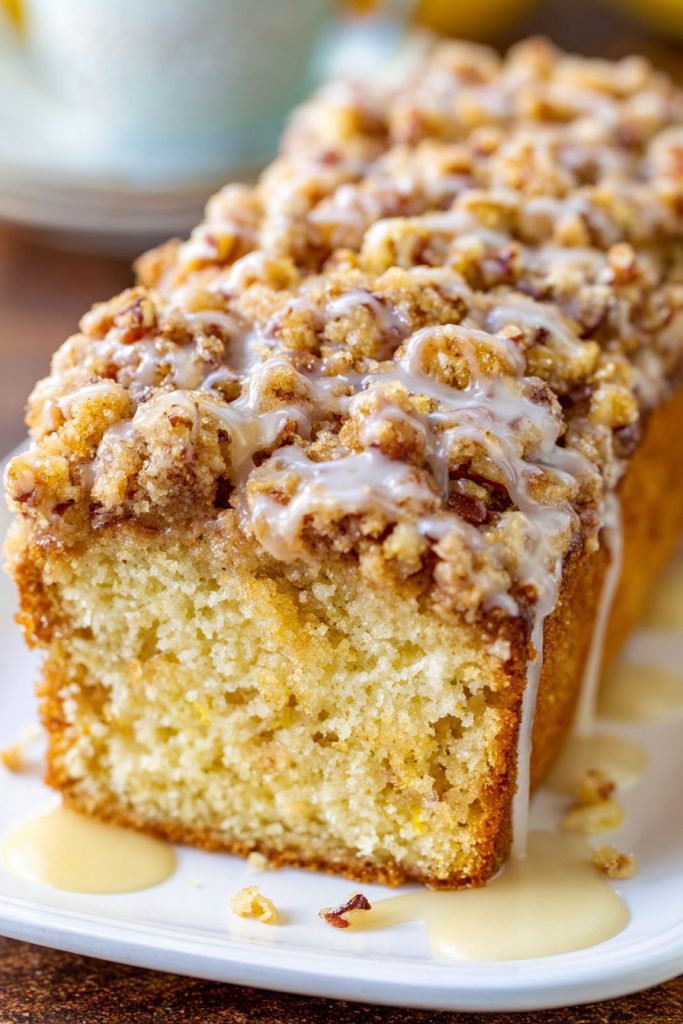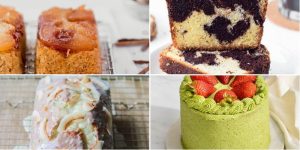Unlocking the vibrant potential of citrus in baked goods requires precise technique and balanced formulation. This lemon coffee cake achieves exceptional texture and flavor complexity through methodical layering and temperature control, offering professional bakers an opportunity to showcase their skills with this sophisticated yet approachable creation that elevates traditional coffee cake to new heights.
Why This Recipe Works
- The dual-layer crumb structure creates textural contrast between the tender cake base and the crunchy streusel topping, achieved through precise fat-to-flour ratios and proper chilling techniques that maintain structural integrity during baking
- Fresh lemon zest and juice provide authentic citrus flavor without artificial notes, while the acid content tenderizes the crumb and balances the sweetness, creating a sophisticated flavor profile that evolves with each bite
- Buttermilk incorporation ensures optimal moisture retention and subtle tanginess that complements the lemon, with the lactic acid reacting with baking soda for consistent rise and delicate, open crumb structure
- Temperature-controlled butter preparation creates the ideal emulsion for both cake and streusel, ensuring proper aeration in the batter and flaky texture in the topping through careful monitoring of butter consistency
- Lemon glaze application timing is scientifically determined to achieve optimal absorption without compromising structural integrity, creating a glossy finish that enhances both visual appeal and flavor distribution
Ingredients
- 2 cups all-purpose flour, sifted and measured by weight for accuracy
- 1 cup granulated sugar, divided between cake batter and streusel components
- 1/2 cup unsalted butter, cold and cubed for streusel topping
- 1/2 cup unsalted butter, room temperature for cake batter
- 3 large eggs, brought to room temperature for optimal emulsion
- 1 cup buttermilk, at room temperature for consistent chemical reaction
- 2 tablespoons fresh lemon zest, finely grated to maximize oil extraction
- 1/4 cup fresh lemon juice, strained to remove pulp and seeds
- 2 teaspoons baking powder, aluminum-free for neutral flavor
- 1/2 teaspoon baking soda, properly activated by acidic ingredients
- 1/2 teaspoon fine sea salt, to enhance flavor complexity
- 1 teaspoon pure vanilla extract, for aromatic depth
- 1 cup powdered sugar, sifted for smooth glaze consistency
- 1/2 cup chopped pecans, toasted to develop nutty aroma
Equipment Needed
- 9-inch springform pan for easy removal and clean edges
- Stand mixer with paddle attachment for consistent creaming
- Digital kitchen scale for precise ingredient measurement
- Instant-read thermometer for accurate temperature verification
- Microplane zester for maximum citrus oil extraction
- Wire cooling rack for proper air circulation
- Pastry blender for perfect streusel texture
- Silicone spatula for thorough bowl scraping
Instructions

Prepare the Streusel Topping
Begin by combining 1/2 cup cold cubed butter with 1/4 cup granulated sugar, 1/2 cup all-purpose flour, and 1/2 cup toasted chopped pecans in a medium mixing bowl. Use a pastry blender to cut the butter into the dry ingredients until the mixture resembles coarse crumbs with pea-sized butter pieces remaining. This technique, known as sablage, creates the ideal texture for streusel that will maintain crunch during baking. The key is maintaining butter temperature below 60°F to prevent premature melting and ensure flaky layers. Transfer the completed streusel to the refrigerator and chill for minimum 30 minutes to solidify the fat content, which prevents absorption into the cake batter during baking. Proper chilling ensures the streusel maintains structural integrity and creates the desired crunchy texture contrast against the tender cake base.
Cream Butter and Sugar for Cake Base
Using a stand mixer fitted with the paddle attachment, combine 1/2 cup room temperature butter with 3/4 cup granulated sugar at medium speed for exactly 4-5 minutes until the mixture becomes pale yellow and visibly increased in volume. This creaming process incorporates air cells that will expand during baking, creating the cake’s light texture. The butter should register 65-68°F on an instant-read thermometer for optimal emulsion—too cold and it won’t incorporate air properly, too warm and it will collapse during mixing. Scrape the bowl thoroughly with a silicone spatula to ensure homogeneous mixture, paying particular attention to the bottom where unmixed ingredients often accumulate. Add three room-temperature eggs one at a time, mixing for 30 seconds after each addition until fully incorporated before adding the next, which prevents the emulsion from breaking and ensures even distribution throughout the batter.
Combine Dry Ingredients and Create Batter
In a separate bowl, whisk together the remaining 1 1/2 cups all-purpose flour, 2 teaspoons baking powder, 1/2 teaspoon baking soda, and 1/2 teaspoon fine sea salt until thoroughly combined and aerated. This dry ingredient premix ensures even leavening distribution and prevents localized chemical reactions that could create tunnels or uneven texture. With the mixer on low speed, alternate adding the dry mixture and 1 cup room temperature buttermilk to the creamed butter mixture, beginning and ending with dry ingredients. This alternating method maintains the emulsion while preventing gluten overdevelopment. Halfway through this process, incorporate 2 tablespoons fresh lemon zest and 1 teaspoon vanilla extract, mixing just until combined. The batter should appear smooth and homogeneous without visible streaks, but avoid overmixing which would develop excess gluten and create a tough crumb structure.
Assemble and Bake the Coffee Cake
Prepare a 9-inch springform pan by thoroughly greasing the bottom and sides, then lining the bottom with parchment paper for guaranteed release. Transfer the completed batter to the prepared pan, using an offset spatula to spread it into an even layer that reaches all edges uniformly. Remove the chilled streusel from refrigerator and distribute it evenly across the batter surface, gently pressing it just enough to adhere without submerging into the wet batter. Place the pan in the center rack of a preheated 350°F oven and bake for 45-50 minutes until the internal temperature reaches 205-210°F on an instant-read thermometer inserted into the center. The cake should display golden brown edges, the surface should spring back when gently pressed, and a toothpick inserted near the center should emerge with moist crumbs rather than wet batter.
Prepare and Apply Lemon Glaze
While the cake cools in its pan on a wire rack for exactly 15 minutes, prepare the lemon glaze by whisking together 1 cup sifted powdered sugar with 1/4 cup fresh lemon juice until completely smooth and free of lumps. The glaze consistency should coat the back of a spoon but still flow slowly—if too thick, add lemon juice 1 teaspoon at a time; if too thin, add powdered sugar 1 tablespoon at a time. After the initial cooling period, run a thin knife around the pan edges and carefully release the springform mechanism. Drizzle the glaze evenly over the warm (not hot) cake surface, allowing it to soak in slightly while maintaining a glossy finish. The ideal cake temperature for glazing is 90-100°F, which allows partial absorption while preserving visual appeal. Complete cooling to room temperature before slicing to ensure clean cuts and fully developed flavors.
Tips and Tricks
For professional-level results, consider these advanced techniques that elevate the basic recipe. When zesting lemons, use only the yellow outer layer and avoid the white pith beneath, which contains bitter compounds that can compromise flavor balance. For maximum oil extraction, zest directly over your mixing bowl to capture the volatile citrus oils that would otherwise evaporate. Temperature control extends beyond ingredient preparation—ensure your oven is properly calibrated using an independent oven thermometer, as even a 25°F variance can significantly impact baking time and texture development. When testing for doneness, rely on multiple indicators rather than a single method: internal temperature should reach 205-210°F, the edges should pull slightly from the pan sides, and the surface should spring back when gently pressed. For exceptional crumb structure, consider the reverse creaming method where dry ingredients are combined with butter before adding liquids—this coats flour particles with fat, limiting gluten development for an exceptionally tender texture. Storage considerations include allowing the cake to cool completely before covering to prevent condensation, and if refrigerating, bring to room temperature before serving to restore optimal texture and flavor release. For make-ahead convenience, the streusel can be prepared and frozen for up to three months, and the dry ingredients can be pre-mixed and stored airtight for quicker assembly. When scaling the recipe, maintain precise ratios rather than simple multiplication—especially with leavening agents, which don’t scale linearly. For professional presentation, use a serrated knife with a gentle sawing motion to slice clean portions without compressing the delicate crumb structure.
Recipe Variations
- Lemon Blueberry Coffee Cake: Incorporate 1 cup fresh blueberries tossed in 1 tablespoon flour to prevent sinking, and add 1/2 teaspoon almond extract to complement the berry flavor. The berries create pockets of jammy fruit throughout the cake, while the almond adds aromatic complexity that bridges the citrus and berry notes. Reduce lemon zest to 1 tablespoon to avoid overwhelming the delicate blueberry flavor, and consider adding a lemon-blueberry compote layer between the cake and streusel for intensified fruit presence.
- Lemon Poppy Seed Variation: Add 2 tablespoons poppy seeds to the dry ingredients and increase lemon zest to 3 tablespoons for amplified citrus notes. The poppy seeds provide subtle crunch and visual interest while their nutty flavor creates sophisticated contrast with the bright lemon. For enhanced texture, replace 1/4 cup of all-purpose flour with finely ground almonds, which contributes moistness and complements the poppy seed flavor profile. Consider adding a lemon-poppy seed glaze by incorporating 1 teaspoon poppy seeds into the standard glaze recipe.
- Lemon Lavender Infused Cake: Steep 1 tablespoon culinary lavender buds in the buttermilk for 30 minutes before straining, and add 1/2 teaspoon lavender extract to the batter. The floral notes create an elegant pairing with lemon’s brightness, offering sophisticated flavor complexity suitable for special occasions. Complement with a lavender-infused glaze by steeping 1 teaspoon lavender buds in the lemon juice for 15 minutes before straining and proceeding with the standard glaze recipe. Garnish with edible lavender flowers for visual appeal that matches the refined flavor profile.
- Lemon Ricotta Coffee Cake: Replace 1/2 cup buttermilk with 3/4 cup whole milk ricotta cheese, drained and whisked until smooth. The ricotta contributes exceptional moisture and delicate tanginess while creating a denser, more substantial crumb structure. Increase baking powder to 2 1/2 teaspoons to compensate for the additional density, and consider adding a ricotta layer between the cake batter and streusel for textural variation. This variation produces a cake with Italian-inspired flavors that maintains the bright lemon character while offering richer mouthfeel.
Frequently Asked Questions
Can I substitute bottled lemon juice for fresh in this recipe?
While technically possible, bottled lemon juice lacks the complex flavor compounds and aromatic oils present in fresh citrus, resulting in a flat, one-dimensional lemon flavor. Fresh lemon juice contains volatile compounds that provide brightness and complexity, while the zest contributes essential oils that deliver the true lemon essence. Bottled juice often contains preservatives and may have a cooked or metallic aftertaste that can compromise the sophisticated flavor profile. For optimal results, use freshly squeezed juice from ripe, room-temperature lemons that yield maximum juice, and always incorporate the zest for complete citrus expression. If substitution is necessary, increase the quantity by 25% and consider adding 1/4 teaspoon lemon extract to approximate the missing aromatic components.
Why does my streusel topping sink into the batter during baking?
Streusel sinking typically results from improper butter temperature or insufficient chilling before application. The butter in your streusel should remain below 60°F throughout preparation to maintain structural integrity when it hits the oven’s heat. Additionally, ensure your cake batter isn’t overmixed or too thin—overmixing develops excess gluten that can’t support the streusel weight, while thin batter lacks the viscosity to suspend the topping. Chill your streusel for minimum 30 minutes (preferably 60 minutes) to solidify the fat content, and avoid pressing it into the batter during application. The cake batter should be sufficiently thick to hold an impression when pressed with a finger—if it appears runny, add 1-2 tablespoons additional flour to achieve proper consistency before topping with streusel.
How should I store leftover coffee cake and for how long?
Proper storage maintains texture and flavor for optimal enjoyment. Cool the cake completely to room temperature before covering to prevent condensation that creates sogginess. Store at room temperature in an airtight container for up to 3 days, placing parchment between layers if stacking slices. For longer storage, wrap individual portions tightly in plastic wrap followed by aluminum foil and freeze for up to 3 months—thaw overnight in refrigerator before bringing to room temperature for serving. Avoid refrigeration unless necessary in high-humidity environments, as refrigeration accelerates starch retrogradation that creates dryness. To refresh day-old cake, warm individual slices in a 300°F oven for 5-7 minutes to restore texture and aroma before serving.
Can I make this recipe gluten-free or with alternative flours?
Successful gluten-free adaptation requires careful flour blend selection and hydration adjustment. Replace all-purpose flour with a 1:1 gluten-free baking blend containing xanthan gum, increasing liquid by 2-3 tablespoons to compensate for different absorption rates. For optimal texture, consider using 50% almond flour and 50% gluten-free blend, which provides moisture and structure while complementing the lemon flavor. Expect a denser crumb and slightly shorter shelf life with gluten-free versions. When measuring alternative flours, use weight rather than volume for accuracy, as density variations significantly impact results. Baking time may increase by 5-10 minutes—rely on internal temperature (205-210°F) rather than visual cues for doneness determination with gluten-free adaptations.
Summary
This sophisticated lemon coffee cake achieves perfect balance through precise technique and quality ingredients, delivering bright citrus flavor complemented by tender crumb and crunchy streusel. Masterful temperature control and proper mixing methods ensure consistent professional results worthy of any baker’s repertoire.
Lemon Coffee Cake
6
servings25
minutes50
minutesIngredients
Instructions
- 1 Prepare streusel by combining cold butter, 1/4 cup sugar, 1/2 cup flour, and pecans until crumbly, then chill 30 minutes
- 2 Cream room temperature butter with 3/4 cup sugar for 4-5 minutes until pale and fluffy, then incorporate eggs one at a time
- 3 Whisk remaining dry ingredients, then alternate with buttermilk into butter mixture, adding lemon zest and vanilla
- 4 Spread batter in prepared 9-inch springform pan, top with chilled streusel, and bake at 350°F for 45-50 minutes until 205°F internal temperature
- 5 Cool 15 minutes, then glaze with powdered sugar and lemon juice mixture and cool completely before serving



